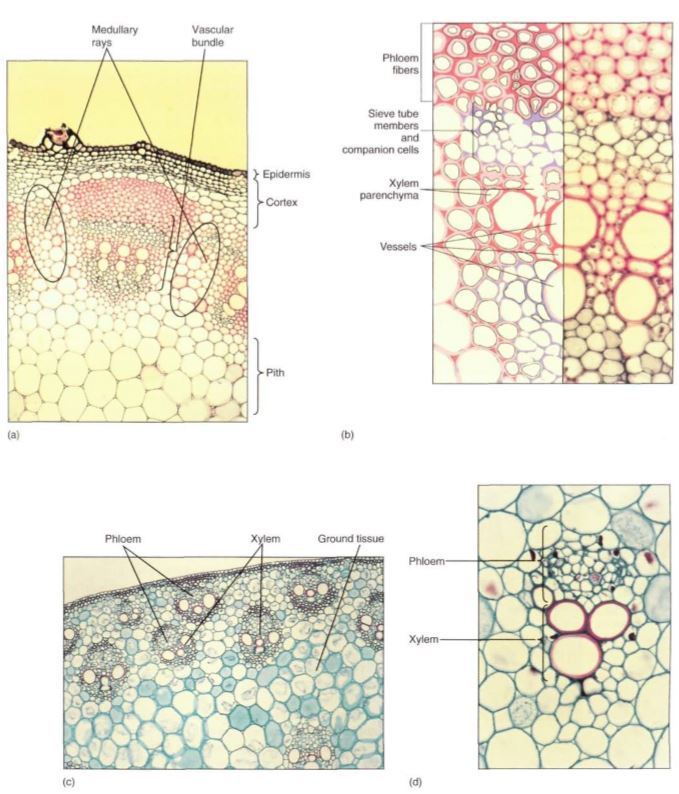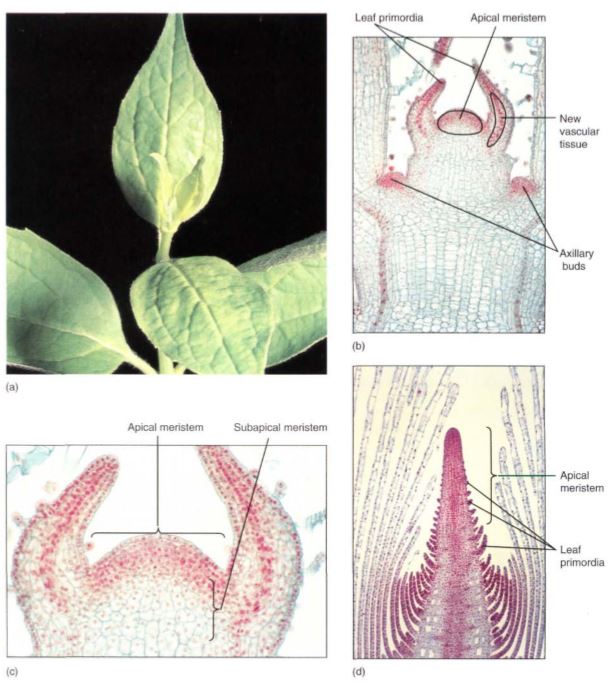


 النبات
النبات
 الحيوان
الحيوان
 الأحياء المجهرية
الأحياء المجهرية
 علم الأمراض
علم الأمراض
 التقانة الإحيائية
التقانة الإحيائية
 التقنية الحيوية المكروبية
التقنية الحيوية المكروبية
 التقنية الحياتية النانوية
التقنية الحياتية النانوية
 علم الأجنة
علم الأجنة
 الأحياء الجزيئي
الأحياء الجزيئي
 علم وظائف الأعضاء
علم وظائف الأعضاء
 الغدد
الغدد
 المضادات الحيوية
المضادات الحيوية|
Read More
Date: 27-10-2015
Date: 23-10-2016
Date: 31-10-2016
|
Stem Growth and Differentiation
Stems grow longer by creating new cells at their tips, in regions known as shoot apical meristems; cells divide by mitosis and cytokinesis, producing progenitor cells for the rest of the stem (Fig. 2). When each cell divides, the two daughter cells are half the size of the mother cell, but they quickly grow back to the original size. As they expand, they automatically push the meristem upward; the lower cells are left behind as part of the young stem. This region just below the apical meristem is the subapical meristem, and its cells are also dividing and growing, producing cells for the region below.

FIGURE 1: (a) In this vascular bundle of sunflower (Helianthus), the xylem contains rows of vessels alternating with rows of xylem parenchyma. The phloem contains sieve tube members and companion cells. There is a large sclerenchyma cap of phloem fibers (X 60). (b) The same bundle, shown at higher magnification (X 250). (c) The vascular bundles of monocots have a more complex arrangement. In this corn stem, many large bundles are located near the cortex and fewer, smaller bundles in the ground tissue (X 50). (d) High magnification of a corn bundle, showing primary xylem and phloem (X 250).
In the subapical meristem, visible differentiation begins; certain cells stop dividing and start elongating and differentiating into the first tracheids or vessel elements of the vascular bundles (Figs. 1 and 3). Because they constitute the first xylem to appear, they are called protoxylem. The cells around them continue to grow and expand, but soon those just exterior to them also begin to differentiate; because these had expanded for a longer time, they develop into tracheary elements that are even larger than the first. This process continues until the last cells mature and this portion of the stem stops elongating. Because these cells have had the longest time for growth before differentiation, they develop into the largest tracheary elements of all, called metaxylem.

FIGURE 2: (a) This shoot tip has several fully expanded leaves, one set of small leaves, and another set of even smaller, younger leaves. Dissection would reveal even more, younger leaves. (b) A longitudinal section through a shoot tip of Coitus showing the apical meristem and leaf primordia of various ages. Two axillary buds are just recognizable as small outgrowths (X 100). (c) A higher magnification of the Coleus shoot apical meristem. Vascular tissue is differentiating in the center of each leaf primordium (X 200). (d) This apical meristem of Elodea is much taller and narrower than that of the Coleus in (c), and it has many more leaf primordia (X 50).

FIGURE 3: Development of three tracheary elements. (a) All cells are young, small, and cytoplasmic. (b) The first protoxylem element forms while all cells are still small. (c) Cells 2 and 3 continue growing, stretching cell 1, which is dead. (d) and (e) Cell 2 matures while cell 3 continues to grow, stretching cells 1 and 2. Cell I has been stretched so much that it is on the verge of being torn open. (f) All elongation has stopped, and cell 3 differentiates as a pitted element. The primary wall of cell 1 has been torn and no longer conducts. Cell 2 is probably still capable of carrying water.
Size is not the only difference between tracheary elements of the protoxylem and the metaxylem. Because protoxylem elements differentiate while the surrounding cells are still elongating, they must be extensible and so must have either annular or helical secondary walls. Although protoxylem cells are dead at maturity, they stretch because they are glued by their middle lamellas to the living, elongating cells that surround them. If protoxylem had scalariform, reticulate, or pitted secondary walls, the cells could not be stretched and either they would prevent the surrounding cells from growing or the middle lamellas would break and the cells would tear away from each other. This is not a problem for the metaxylem, however, because its cells differentiate only after the surrounding stem tissues have stopped elongating. Because metaxylem cells do not have to be extensible, any type of secondary wall is feasible.
A similar process occurs in the outer part of each vascular bundle: The exterior cells mature as protophloem, and the cells closest to the metaxylem become metaphloem. Because the sieve elements do not have secondary walls, the walls of protophloem and metaphloem are identical. However, sieve elements are extremely sensitive to being stretched and die when stressed too much. Consequently, protophloem cells are extremely short-lived, often functioning for only 1 day. Perhaps because they are so temporary, protophloem cells never become well differentiated; their sieve areas are small and rudimentary, and many do not have companion cells. The sieve elements of the metaphloem do not differentiate until later, when all surrounding cells have stopped expanding. Metaphloem cells differentiate fully, having large sieve areas and conspicuous companion cells.
You might expect metaphloem cells to be very large, like those in the metaxylem, but they are much smaller, even though they have undergone long periods of expansion babe differentiation.
All cells of the region are expanding, whether they are dead functioning protoxylem, dead nonfunctioning protophloem, or living undifferentiated metaxylem and metaphloem. Cell size differs because cell division is still occurring in some cells but not in others. In xylem, all cells stop dividing, so each cell becomes larger as the tissue expands —protoxylem cells by being stretched, the soon-to-be metaxylem cells by their own growth. Protophloem cells stop dividing and differentiate, but other phloem cells continue to divide so they remain small.
Other tissues also differentiate in the subapical region. In the epidermis, the first stage of trichome outgrowth may be visible in the youngest internodes, those closest to the apical meristem. In lower, older internodes, trichomes are more mature, and guard cells and stomatal pores may be forming. The cuticle is extremely thin at the apical meristem, but it is thicker in the subapical region and may be complete several internodes below the shoot apex. Differentiation of the pith typically involves few obvious changes: Cells enlarge somewhat, intercellular spaces expand but remain rather small, and cell walls continue to be thin and unmodified. All changes are usually completed quickly, while the cells are in or just below the subapical meristem. Similar changes occur in the cortex, except that plastids develop into chloroplasts. Protoxylem and protophloem develop quickly while the cells are still close to the apical meristem, but metaxylem and metaphloem do not begin to differen¬tiate until the nodes and internodes have stopped elongating.
Because the terms "epidermis," "cortex," "phloem," "xylem," and "pith" typically rfr to the mature cells and tissues, it is confusing to use them for the young, developing cells during differentiation. To prevent misunderstandings, a special set of terms has been agreed on: Protoderm refers to epidermal cells that are still meristematic and in the early stages of differentiation. Young cells of xylem and phloem are referred to as provascular tissues; the equivalent stages of pith and cortex are ground meristem (Fig. 4). Thus the subapical meristem consists of protoderm, ground meristem, provascular tissue, and moe ground meristem. The rate of maturation varies greatly from species to species and abo from one type of stem to another on the same plant. In some cases, maturation is slow and immature tissues can be found many internodes below the shoot apical meristem. In others, differentiation may be completed quickly and all tissues are mature close to the stem apex.

FIGURE 4: Cells of the apical meristem give rise to three types of subapical cells, which in turn give rise to particular types of mature primary tissues. Epidermis develops only from protoderm, never from provascular tissue or ground meristem; other cell lineages in the primary body are also quite simple and linear.



|
|
|
|
دراسة يابانية لتقليل مخاطر أمراض المواليد منخفضي الوزن
|
|
|
|
|
|
|
اكتشاف أكبر مرجان في العالم قبالة سواحل جزر سليمان
|
|
|
|
|
|
|
المجمع العلمي ينظّم ندوة حوارية حول مفهوم العولمة الرقمية في بابل
|
|
|